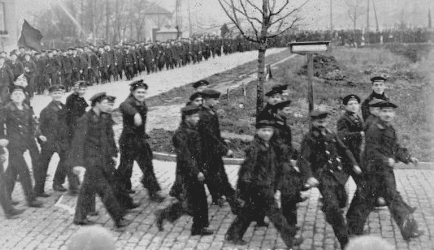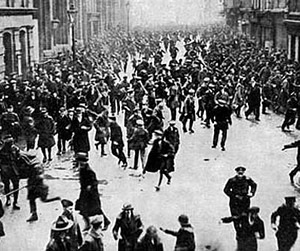

Some of them simply refused to follow orders and took absence of their ships, while others sabotaged their ships’ readiness to sail. Although they were unaware of the operational plan, a significant number of sailors and stokers grew worried by the preparations and they began a small-scale mutiny during the final days of October 1918. Some of the leading voices calling for the operation also considered it possible that the navy’s sacrifice could reignite the German population’s “will” to continue the war.
Kiel mutiny full#
They also feared that the officer corps would lose honour if the war came to an end without the full deployment of the surface fleet, something that had been considered too great a risk up to this point in the war. The men behind the operation were especially worried by the prospect that their ships, built at tremendous cost since the turn of the century, would be surrendered to Britain as part of an Armistice deal. Over the course of the remainder of the month, as the diplomatic exchange of notes began to discuss terms of an Armistice, led by Admiral Reinhard Scheer (1863-1928), the German Navy’s highest command set in place secret plans for a major naval assault upon the Royal Navy. The leadership of the German Navy was shocked by this prospect and refused to believe that Germany was defeated. In his first note, Prince Max requested that Wilson bring an end to the war upon the basis of his fourteen points. statue lies toppled on the ground.On 3 October 1918 the new German government led by Prince Max von Baden (1867-1929) initiated an exchange of diplomatic notes with US President Woodrow Wilson (1856-1924). The French newsreel "Annales de la guerre" held by the Imperial War Museums in London shows the arrial of the troops and French prisoners of war on their way home, while soldiers’ councils – partly in uniform, partly plain-clothed – maintain a sentry post on the Kehl bridge.

Therefore, already in mid-November, French troops arrived in Alsace-Lorraine. "Ici commence le pays de la liberté"- The Republic of Alsace-Lorraine was a proclaimed independent nation that only existed for a few days as the plans of the Entente Powers foresaw the annexation of Alsace to France. La Commmoration des Grandes Heures de l’armistice (1918-1922) On the very same day, thousands of people flood the streets in Great Britain and France to celebrate as the footage from the Imperial War Museum in London and from the Cinémathèque Royal de Belgique in Brussels show.Īrmistice Day celebrations in Glasgow and Dublin 11th November 1918 - TOPICAL BUDGET 377-2 Keizer Wilhelm in Eijsden / Kaiser Wilhelm in Eijsden (1918)ġ1th November 1918: Representatives of the German Reich, France and Great Britain sign the armistice in a railway carriage in the Forest of Compiègne about 60 km north of Paris.

Just a day later, on the 11th of November, Germany signed the Armistice of Compiègne which amounted to the complete German demilitarization. "Keizer Wilhelm in Eijsden" from the collection of EYE Filmmuseum in Amsterdam shows footage of the commotion that the Emperor's arrival caused at the station. was waiting at the Eijsden railway station for the Dutch government to issue his official permission to cross the German-Dutch border. Matrosen in Berlin (DDR 1978) / Sailors in Berlin (GDR 1978)ġ0th of November: While workers' councils and soldiers' councils were elected in factories and barracks throughout Berlin, Kaiser Wilhelm II. "Sailors in Berlin" from the collection of the Deutsche Kinemathek in Berlin is one of the few films that show the rare footage of the Sailors revolt and the November revolution in Germany. From there, it didn’t take long for the spirit of the revolution to spread through the entire country. Only two hours after Scheidemann’s proclamation, Karl Liebknecht of the Spartacist League proclaimed a "Free Socialist Republic". abdicated as German Emperor and in Berlin, Social Democrat Phillip Scheidemann proclaimed the German Republic. 9th of November 1918: Just a few days after the Kieler Matrosenaufstand (Kiel mutiny), Kaiser Wilhelm II.


 0 kommentar(er)
0 kommentar(er)
